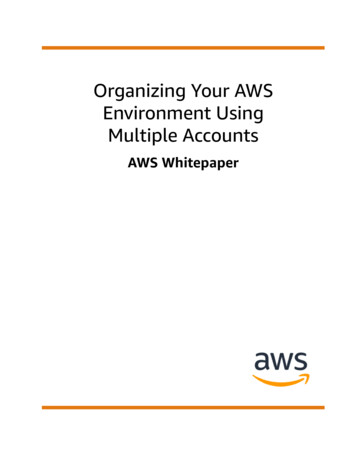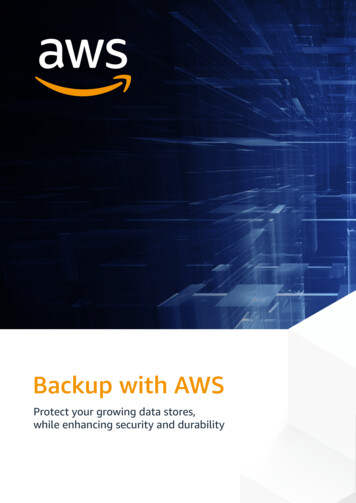
Transcription
Backup with AWSProtect your growing data stores,while enhancing security and durability
Table of Contents3Backup Solutions in Today’s Data Landscape4Benefits of Backing Up to AWS6Architecting Backup for the Cloud8AWS Partner Network and the Storage Competency9How to Get Started
BACKUP SOLUTIONS INTODAY’S DATA LANDSCAPERegardless of industry, size, or location, all organizations experience data loss caused by myriadevents – from unintentional system failures to data center shutdowns. While there are measuresyou can take to mitigate data-loss events, the most effective data-protection method is havingan enterprise-wide backup solution.Everything fails, all the time.– Werner Vogels, AWS CTOBackup in the current data landscapeNew challenges, new toolsDue to the exponential growth of data worldwide,A growing number of organizations are extendingdesigning and deploying backup solutions is moreon-premises backup capabilities to the cloud incomplicated than before. The International Dataorder to accommodate this data growth. WhileCorporation predicts global data will grow to 163the cloud offers numerous benefits, designing andzettabytes by 2025, which is 10 times the amountdeploying an agile backup solution in the cloudof data generated in 2016.*requires careful consideration of your existing ITinvestments, current operating environment, andrecovery objectives.201616ZB163 ZBHow do you achieve greater storagescalability and control, without sacrificing security?2025Traditional backup methods such as tapelibraries cannot quickly scale to this growth andmaintaining them and paying for offsite archivalservices can be prohibitively expensive.THIS IS WHERE AMAZON WEB SERVICES CAN HELP.Data Age 2025, IDC and Seagate, April 2017, ds/files/Seagate-WP-DataAge2025-March-2017.pdf*3
BENEFITS OF BACKING UP TO AWSSince 2006, Amazon Web Services (AWS) has been providing cloud IT infrastructure services tohundreds of thousands of organizations. With AWS, companies can accommodate fluctuating backupdemands in minutes, and no longer waste weeks or months procuring servers and other infrastructure.In addition to increased scalability, organizations are realizing major benefits of extending backuptargets to the AWS Cloud:COST EFFICIENCIES AND REDUCTION OF TOTAL COST OF OWNERSHIPWith pay-as-you-go pricing, no upfront capital investments, and cost management tools,AWS customers can spend efficiently. When properly designed, extending backups to theAWS Cloud can serve as the first step in reducing total cost of ownership and your physicaldata center footprint.ENHANCED DATA DURABILITY AND AVAILABILITYOur data security and replication protocols are designed to deliver 99.999999999%durability for all objects stored in AWS. Copies of every object are distributed across atleast three physical Availability Zones that are miles apart within an AWS Region. Evenwhen practicing industry best practices, on-premises capabilities cannot match AWS’durability due to our global scale.MORE SECURITY WITH AWS THAN ON-PREMISESAll AWS customers benefit from a data center and network architecture built to meetthe requirements of the most security-sensitive organizations in the most regulatedindustries, such as Financial Services, Public Sector, and Healthcare. We offer services tomanage account access, detect irregular activity, isolate DDoS attacks, encrypt data intransit and at rest, and perform audits. AWS also maintains numerous security assuranceprograms, which means segments of your compliance are already completed.ACCESS TO THE LATEST MACHINE LEARNING AND ANALYTICS TOOLSAnother benefit of backing up to AWS is the access your backup data has to the latestcloud-native applications for artificial intelligence, machine learning (ML), analytics,and business intelligence. This means you can extract insights from data sets that intraditional backup architectures would sit idle until recovered for production.AWS’ data center and network architecture is built to meet the requirements of the mostsecurity-sensitive organizations in the world. This is why enterprises like Kellogg’s, Unilever,NASA JPL, Thomson Reuters, and the Financial Times back up and protect data with AWS.4
ON-PREMISES BACKUPAWS-POWERED BACKUPWait weeks or monthsfor resourcesScale IT resourceson-demandStore backups withlimited durabilityStore backups with11 9’s of durabilityOperate within-house securityOperate withglobal-scale securityLeave backupdata idleRun ML and analyticson backup data“Most important to us is that we save time. Backups are not a strategic part ofour business . We were looking to hire people to support this archaic system andnow we’re looking to reutilize these guys to help with our acquisitions and buildout better infrastructures for us.”– Jason Cradit, Senior Director of Technology at TRC SolutionSTORAGE SERVICESAWS offers the most storage services to store and protectAWS is designed to deliverdata in the cloud. All of these services are supported by theon a customer promise ofAWS infrastructure, which allows them to be flexible, durable,99.999999999%scalable, and secure.durability of objects storedAMAZON SIMPLE STORAGE SERVICE(AMAZON S3) Object storagein Amazon S3 andAMAZON S3 GLACIERIn theory, you can expectCold storage / ArchiveAWS STORAGE GATEWAYHybrid storageAWS BACKUPFully managed backup serviceAmazon S3 Glacier.a loss of one object of 10million stored in AWS, every10,000 years.5
ARCHITECTING BACKUP FOR THE CLOUDThere are a range of architectural designs you can choose from that leverage the benefits ofthe AWS Cloud. If your current infrastructure and data are on-premises, consider a hybrid-cloudsolution. For organizations already running on AWS, there are efficient cloud-native designs andfeatures that can maximize your backup strategy and evolve it into more complex workloads forarchiving and disaster recovery.HYBRID-CLOUD BACKUP ARCHITECTUREPRO TIPA lot of commonly-used backup software haveTo increase your ability to scale, protect, andbuilt-in cloud connectors that, when enabled,restore backups, consider hosting backupengines and points of control in AWScan send data backups to the AWS Cloud for short-(as opposed to on premises). This modificationand long-term storage. If your on-premises backupcan facilitate faster data restores for use withsoftware cannot write directly to the cloud, use athe latest AWS Cloud-native applications forgateway service such as AWS Storage Gateway tomachine learning and analytics. In-cloud datacreate a seamless connection between yourrestores are also critically helpful when datacenters are corrupted or unavailable; you canon-premises environment and AWS storage servicesreplicate your on-premises environment inAmazon S3 and Amazon S3 Glacier. During a restore,the cloud using AWS services and continuebackup data is pulled back to the on-premisesrunning applications with your backup data.environment and reinstatiated for production.Networking OptionsBackupMaster ServerLocal S3Backup TargetAmazon S3AWS StorageGatewayAWS DirectVPNConnectGatewayVTLBackup ClientsPartnerBackup SoftwareBackup TargetBackup Target OptionsS3 APIInternetAmazon S3 GlacierAWS RegionCustomer Data CenterPartner provided solution in blue.On-PremisesCloud (AWS)6
CLOUD-NATIVE BACKUP ARCHITECTUREWhen your backup software, engines, servers, data, and storage are hosted on AWS, all theseresources automatically scale to demand. There are no external resources required and customerscan deploy solutions supported by the AWS Partner Network (APN) if collaborating with athird-party is preferred (see the AWS Partner Network section on page 8 for more information).Customers can use the Amazon EBS snapshot feature to back up and protect databases and filesystems that are running on AWS’ compute service Amazon Elastic Compute Cloud (Amazon EC2).VPCCustomerBackup ClientPartnerBackup SoftwareBackupMaster ServerBackup /RestoreAmazonS3S3 EndpointBackup TargetAmazonS3 GlacierAWS RegionPartner provided solution in blue.AMAZON EBS SNAPSHOTSAmazon Elastic Block Store (Amazon EBS) provides the underlying storage for applications that runon Amazon EC2, such as databases and file systems. This means customers can use the Amazon EBSsnapshot feature to back up and protect these applications and their respective data sets. It works bycreating an exact replica of an Amazon EBS volume at a specific point-in-time.After an EBS snapshot is created, it is stored as an object in an Amazon S3 bucket and inherits the datadurability and replication features that support all other objects stored in Amazon S3. Amazon EBSsnapshots are incremental, which means only changes since the last snapshot are saved.7
CLOUD-NATIVE BACKUP ACROSS AWS SERVICESAWS Backup is a fully managed, policy-based backup solution that makes it easy to automaticallyback up your application data across AWS services in the cloud as well as on premises using theAWS Storage Gateway. AWS Backup’s policies provide automated backup scheduling, backupretention management, and lifecycle rules, helping to streamline backup processes. AWS Backup’scentralized backup monitoring, backup encryption, and backup access policy features help you tomeet internal and regulatory backup compliance requirements.Amazon EFSAWS BackupCreate backup planMakes it easy to centrallymanage backups in the AWSCloud via console, APIs, or CLIBackup frequency,retention policyAWS StorageGatewayMonitorAmazonDynamoDBModifyAmazon RDSAmazon EBSBackupResources automaticallybacked up according tobackup plan usingAmazon S3RestoreAssign AWS resourcesAWS Backup supports backing up Amazon EBS volumes, Amazon RDS databases, Amazon DynamoDBtables, Amazon EFS file systems, and AWS Storage Gateway volumes and stores your backup datadurably and securely using Amazon S3.8
AWS PARTNER NETWORK, THE STORAGECOMPETENCY, AND THE AWS MARKETPLACEFor organizations with complex legacy IT investments, extending backup targets to the AWS Cloudmay require significant resource reallocations, budget changes, and training.To help, the AWS Partner Network (APN) – the largest ecosystem of cloud service providers –recognizes Storage Competency Partners that can help deploy backup strategies that leverage AWSservices and your existing IT investments and processes. All APN partners have validated their technicalAWS expertise and proven customer success of their services and products. If your on-premisesbackup provider is already an APN member, you can work with them directly to enable built-in cloudconnectors or deploy gateways that extend backup targets to the AWS Cloud. For customers lookingfor new capabilities, the APN can help narrow down the list of providers that best fit your requirementsand then you can explore their solutions on the AWS Marketplace.The AWS Marketplace is a digital catalog offering 3,500 software listings from 1,100 independent software vendors recognized by the APN for AWS expertise and proven customersuccess. Find, buy, and start using backup solutions today.Whether you’re extending on-premises backup targets to the cloud or creating cloud-native processes,working with an APN backup provider and the AWS Marketplace offers these benefits:LEVERAGING BUILT-IN CAPABILITIESEASING THE CONSTRAINTS OF DEPLOYMENT9
HOW TO GET STARTEDBUILT-IN CLOUDCONNECTORSAWS STORAGEGATEWAYAWSBACKUPAWSMARKETPLACETake a look atTry AWS StorageSign in to your AWSExplore the AWSyour incumbentGateway for freeaccount, launchMarketplace forcapabilities. Thereto extend yourthe AWS Backupfamiliar and newmay be built-in cloudon-premisesconsole, create abackup providers. Findconnectors that canenvironment to thebackup plan, anda solution provider whobe enabled to startAWS Cloud. Theassign AWS resourcescan best accommodatesending backups toservice is easy to use- EBS volumes, RDSyour needs and beginthe AWS Cloud forand can be deployeddatabases, DynamoDBbacking up to the AWSdurable and securein a few steps.tables, EFS fileCloud today!storage.systems, and AWSStorage Gatewayvolumes.VISIT USFor more information about AWS services or tocontact one of our sales representatives, visit us athttp://aws.amazon.com/backup-restore.In addition to service and solution overviews,we also provide hands-on tutorials, tech talks,upcoming events, and technical whitepapers tohelp you evolve your current backup capabilitiesinto comprehensive solutions that durably andsecurely protect your data and your organization.10
can send data backups to the AWS Cloud for short- and long-term storage. If your on-premises backup software cannot write directly to the cloud, use a gateway service such as AWS Storage Gateway to create a seamless connection between your on-premises environment and AWS storage services Amazon S3 and Amazon S3 Glacier. During a restore,

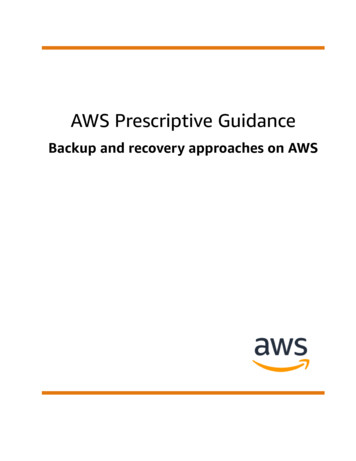


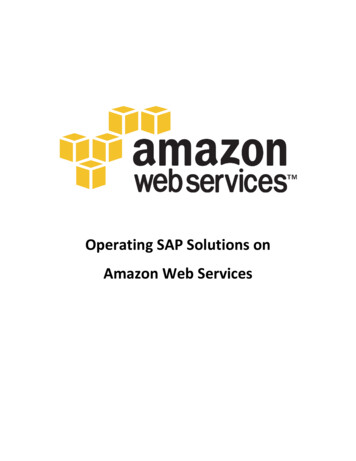



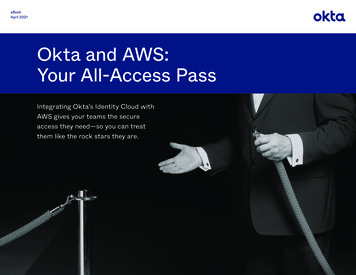
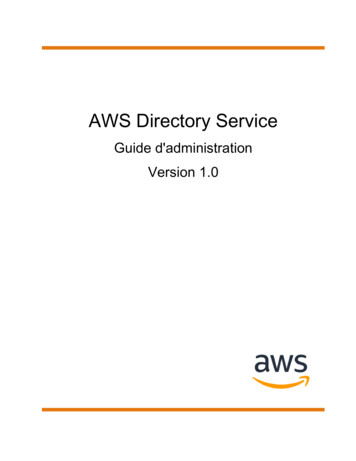
![[AWS Black Belt Online Seminar] AWS X-Ray](/img/17/20200526-blackbelt-x-ray.jpg)
